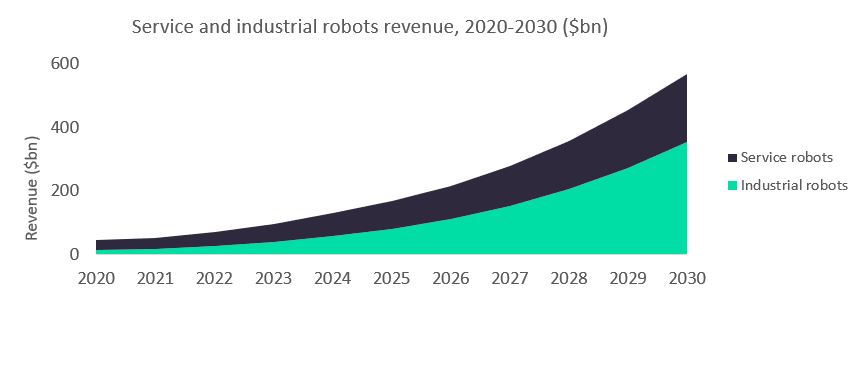Robotics is a fast-growing industry. A recent report from GlobalData forecasts that it will pass the $500bn mark in 2030, after a decade of double-digit annual growth. That’s an impressive figure for an industry that generated global revenue of just $45bn in 2020.
Most of the value generated by robotics comes from service robots, a broad category that includes consumer robots, as well as robots used in logistics, healthcare, security, and many other areas of the service sector. However, industrial robots will grow at a faster rate in the 2020s. Moreover, industrial robots are also a source of innovation that often spills over to service robots.

Robotics has a long history. Ingenious humans have been developing mechanical contraptions to perform hard or dangerous tasks for millennia. Even if we narrow down the robotics story and only consider the period after the emergence of computing, robots have been working alongside humans in factories since the 1960s. Yet, despite the long history, there is sometimes the feeling that robotics has not reached its full potential.
It’s demography and the economy
Several conditions have recently aligned that promise to expand the robotics market. Those conditions are technological, economic, and demographic.
Cloud computing and AI enable robots to collaborate, access huge amounts of data uninterruptedly, and, ultimately, become smarter. Further advances are needed in certain AI technologies, including computer vision, conversational platforms, and context-aware computing, and these developments will not happen overnight. Still, the foundations are in place, and advances are expected over the coming years. Moreover, investors are pouring funds into AI start-ups that aim to make robots more intelligent, independent, and better able to function in unstructured environments.

US Tariffs are shifting - will you react or anticipate?
Don’t let policy changes catch you off guard. Stay proactive with real-time data and expert analysis.
By GlobalDataEven so, technological developments on their own won’t drive growth. Scientific ingenuity and creativity are making progress in robotics possible, but demography and the economy will incentivize harnessing that technology. Before the pandemic, economic growth had started to stagnate in most of the developed world. Growth in large emerging economies, like Brazil and South Africa, had also begun to stall. Automation is vital for improving productivity and gaining a competitive advantage. As countries and companies design their pandemic recovery plans, interest in robotics is increasing.
Unlocking the full potential of robotics
The final incentive for robotics growth comes from demographic trends. Fertility rates are low in large parts of the world while life expectancy keeps increasing, barring the interruption brought about by the pandemic. This used to be a problem of very wealthy nations, but now affects rapidly growing China and middle-income countries too. As a result, societies are increasingly looking to robots to care for the elderly and help solve shortages in the workforce.
AI and cloud computing are making robots smarter and more efficient, but advances in these areas on their own do not explain robotics growth. For technology to enjoy wide adoption, it’s not enough for it simply to exist. In the next decade, incentives for robotics adoption will come from economic and demographic trends, and it’s the combined convergence of these trends with technologic breakthroughs that promise to unlock the full potential of robots.








